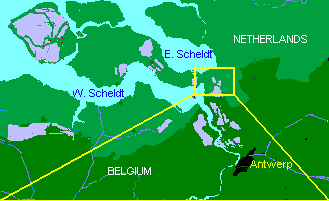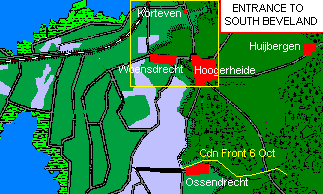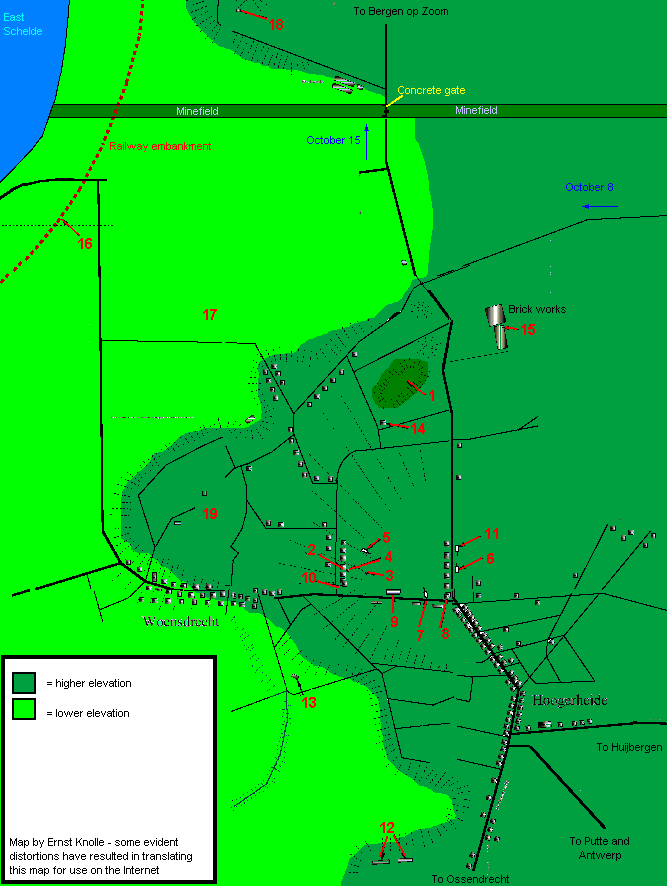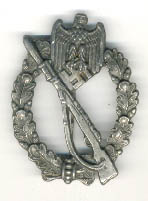The
following account is presented courtesy of Herr Ernst Knolle.
The following is an account of the fighting
around Hoogerheide and Woensdrecht in October 1944; the 2nd Canadian Division at this time
was trying to batter their way through units of Kampfgruppe Chill to open a path to the
South Beveland Peninsula. Until the peninsula was cleared, and the guns on Walcheren
Island at the far end of the peninsula, no Allied shipping could use the port at Antwerp.
As long as the Germans prevented the use of Antwerp, allied supplies would have to
be brought into Northwest Europe through the much smaller port of Dieppe, as well as over
the open beaches in Normandy, and be moved many miles by truck, using up precious
quantities of gasoline as well as requiring large numbers of men, trucks, and the time to
drive the supplies. |
 |
| Ernst Knolle was an artillery observer at this time and
gives a stirring account of what the fighting was like. The Canadian perspective is
given in several well done books, including Tug of War by Denis and Shelagh
Whitaker, The Guns of Victory by George Blackburn, as well as the regimental
histories of several 2nd Division infantry units including the Black Watch, the Royal
Regiment of Canada and the Calgary Highlanders. |
 |

Numbers in yellow refer to points marked on
battlefield map. My position was signal corpsman and advanced observer for our artillery
battery, which was temporarily attached to the 85 Infantry Division, which included
remnants of the Hermann Göring Parachute Regiment. It was a six-day battle, which earned
me the Iron Cross and the Infantry Assault Badge, signed by Commander Kurt Chill. For
better understanding I made a drawing of the battlefield in 1992. A local Dutch book and
maps helped to recall and confirm the events. It is called: "woensdrecht en
hoogerheide in de bange dagen van hun bevrijding." Not far from there is
a British/Canadian Military Cemetery, where I got a shock in 1964 to seen what seemed like
thousands of graves. Even though they were the enemy, it still was a terrible waste. One
ponders if that was really necessary?
Our battery had 120 men, 140 horses, five 105-mm
cannons and numerous ammunition and supply wagons. We did not have a single motor vehicle.
We arrived on October 8th after an all night 40-Km (25 mile) march from
Dortrecht plus another night spend on a 5 Km lateral position change. We were looking for
a place to finally get some sleep. Instead we walked right into a six-day battle. So far
the war for us had consisted of guarding Rommel’s 15th Army Headquarters and playing
with the local girls. Disgustingly, I learn now that unchivalrous Canadians stood by and
watched the poor girls' hair cut off as punishment for fraternizing with us Germans. Shame
on you Canadians! (Page 271, "Semper Paratus" by Royal Hamilton Light Infantry,
Hamilton, Ontario, Canada)
I quickly learned that our order-snapping leadership was great at spit-and-polish and
neatly standing guard, but in battle they were pretty well incompetent. Right from day one
I could see that their bungling would get us all killed. The only exception was Oberleutnant
(First Lieutenant) Schnur who transferred to us from a Paratrooper Division and for
whom I became his personal runner. Points on the map:
(1) Stupid
sergeant made us lay our telephone cable over this hill because he was lost and needed to
go up there to find his bearing, and he was too scared to go alone. I argued with him, and
he told us to do what we were told.
(2)
Fourth house was our battery’s forward control center. Several men took turns running
back and forth along the telephone cable to fix it every time it got hit. The only comrade
from my hometown, Waldemar Eikmann, got killed on the first day as he was fixing a break.
Another guy with him was wounded. I was now really mad and told the sergeant what an SOB
he was. Then I took command, and when darkness set in we pulled the cable off the hill and
relocated it further west and away from the highway, which was constantly under fire. The
result was fewer breaks and no more linesmen got killed or wounded.
(3) My first foxhole, another stupid thing.
Given no telephone and only binoculars, I was sent there to report enemy movements and
targets, which I had to relay back by shouting. Of course, the enemy just as close could
probably hear me too. Despite camouflage, a machine gun opened up on me as soon as I stuck
my head up. I didn't even realize that it was shooting at me. Only when I took my
binoculars off to relax my eyes for a moment did I notice the bullets hitting the dug up
dirt around my foxhole. Then it sunk in. Here I was, the only guy in this wide open area,
pinned down, shells raining all around me, no food, no water, no infantry near me. How can
they send me so far forward where there was absolutely no cover or escape? Then several
enormously loud explosions occurred within a few feet of me, each time followed by two
echoes. A German Tiger tank was firing directly over my head with an 88-mm cannon, the
most powerful tank gun. The first bang was a sonic boom, the second was the hit ahead and
the third the muzzle bangs from behind.
Another one of the many dumb things that happened: While fixing a break in our phone line,
a mortar crewman shouted abuse and demanded that we lob our stuff at the enemy and not at
our own people. Then later, I called for a round on a specific target ahead; instead it
landed behind me. Then later still, when the whole battery fired on enemy positions, there
was always an occasional round that landed about 500 m short. When I reported this, my
officers and NCOs called it nonsense and said that was impossible. I made it my pet
project, and I determined that for the six day battle, our battery fired 20% of the shells
into our own positions, just because my commanders couldn't be bothered to check which
cannon had either its gun sight screwed on wrong, used wet ammunition or had some other
defect.
There was a one hour cease-fire every day to let civilians with white flags leave the
area. The fear of spies was great. Canadian fire seemed closer on target afterwards? Did
someone tell them of our positions? - We had no air defense, and Canadian air strikes came
routinely at the same time each day. On the third day we brought in several anti-aircraft
guns which blew the lead plane up and panicked the others into breaking off their attack.
They dropped their bombs harmlessly (unexploded) and never came back.
The Canadians had a spotter plane, which annoyed us endlessly. I shot at it with my rifle
a few times with no apparent effect. - Canadians had lots of artillery, but often as much
as 80% of their shells didn't explode. I suspected that they fired captured ammunition and
did not know how to set German fuses. I even picked a shell up to look for markings. The
shell was so hot that I almost burned my hands. (I learned in 2001 that Canadian artillery
shells needed to hit hard ground to explode. The ground around us was soft and muddy, and
that is why they didn’t explode) We had some long-range machine guns with which we
sprayed Hoogerheide at night. I wonder if that had any effect? - Six of our heavy mortar
crewmen got killed in an accident during rapid firing. Probably stuffed two rounds on top
of each other. - I heard that one of our companies was captured without firing a shot on
the very first day. They were on bicycles going south along the main highway, when they
passed a column of enemy Sherman tanks going north. Oops! (Shows how stupid our leadership
was.)
About October 9th, a German infantryman called for help across the street in front of
house (10). In the basement with us were a
handful of his buddies, who totally fatigued and depressed said that they are not going
out there again. Then to my horror, my fellow artillery observer, Friedel Steinmeier (FS),
said: "OK, then I get him!" And he did! Except for his helmet, he took all his
gear off and calmly walked across the open field straight to the wounded man, loaded him
on his back and carried him to safety. - I was very impressed that the Canadians held
their fire. Read story (13), where I
returned the favor. FS and I were the only artillerymen who got the Iron Cross. This
happened in the first few days when shooting was too intense to bury or even carry off the
dead. One dead guy was lying behind our house for several days.
About October 11th, Canadians raided house (10) and took about 20 prisoners including almost
all of our observer team. A captain, another guy and myself heard them coming and escaped
just seconds ahead. Suddenly, me with rank of private, was the highest-ranking artillery
advanced observer man left. From captured maps, the Canadians now directed precision fire
at our battery. However, our gun crews managed to save four of the five cannons without
anyone getting hurt. First Lieutenant Schnur, our chief, to whom I was as his runner a
constant companion, told me to stay up front while he was going back to examine the
damage. The unsalvageable cannon stood there abandoned without camouflage. Debris around
it was smoldering. An Allied plane saw it, dived and dropped a bomb on the already
destroyed target. A shrapnel cut our chief across the face as he was hugging the ground.
Medics took him away and I never saw him again.
In the middle of a tank battle
(4) All that gunfire created a haze. When it
got thick enough, I crawled back towards the houses behind me and dug my second foxhole in
a woodshed. I could now look out without being seen, and I had protection against direct
hits from mortar fire. The shooting got heavier again when I noticed two Sherman tanks, (6) and (7),
advancing and rapidly firing. My wood shed was turning into a sieve. Suddenly, a German
tank commander tapped me on the shoulder and asked where the enemy tanks where. I shouted
at him to get down, but he didn't budge. He just stood there and repeated his request.
Knowing that we wouldn't survive the next 5 seconds up there, I did climb out of my
foxhole and in the smoke and haze pointed the Shermans out to him. He immediately ran off
and I, even faster, dropped back into my hole.
(5) A few minutes later, a big German Tiger
tank roared up next to me, stopped and instantly fired a round at Sherman tank (6). However, the shell, grazing the ground,
ricochet off with a spine chilling screech. Yet, it must have also glanced off the Sherman
tank, because I now saw its crew emerge from the conning tower and flee. I fumbled for my
dirt-covered rifle, but was too slow to get off a shot. The German tank now advanced maybe
25 m, a second round flashed across and the Sherman tank blew up. The crew may
nevertheless have gotten killed nearby. Obviously aware of the danger, the other Sherman
tank was by now in full retreat. But our tank commander also didn't wait around to see who
might now shoot at him. He too got into reverse and barreled back down the incline, heaven
help who was in his way. The tank action apparently defeated the Scottish Cmd Black Watch
(Essex Scottish, 5th Brigade) attack on the 8th and 9th. (6)
and (7) shows Sherman tank positions in the
attack as described above. - (8) We were
told not to direct fire at the house of Dutch doctor Van de Kar, J.P.M., because Canadian
and German wounded in addition to civilians were there in the doctor's care.
(9) Someone found beer and fruits here. I
went to get some and was heavily shelled with mortars. I ran right through and one grenade
whizzed by my ear and exploded under me without causing injury. There was a little
depression in the ground and I was leaping across. A bit of luck, I would say. - (10) After the Black Watch attack was beaten
back, we made this house into our main observation post. The Canadians were now advancing
towards Woensdrecht. - (11) In a
counter-attack a German tracked armored cannon with about 30 infantry behind apparently
hit a mine and blew up with a tremendous bang, setting a house and tree on fire.
Apparently everyone got killed. It gave me quite a shock. -
(12) Our whole artillery advance observer group was told to join the
infantry in a 1 a.m. night attack. I had fallen asleep in my foxhole and missed it. My
buddies told me they had charged right through Hoogerheide up to these two brick ovens and
routed three Canadian command posts. Our losses were heavy, and we had to withdraw. I woke
up at 4 a.m. to the screaming of the wounded as they were loaded onto vehicles nearby. I
was horrified.
(13) On October 13, the Canadians were pounding us in preparations for
their attack. Our observation house (10) was
shot into rubble, leaving only the chimney. However, we stuck it out in the cellar. At
dusk it was my turn to go up on watch. With a field telephone and binoculars, I climbed up
the chimney and saw what seemed to be several officers looking over this bunker with
binoculars and having maps before them. I called (whispered) for a single high velocity
artillery round. (A straight shot that gives nobody time to duck). It was right on target
and I saw a steel helmet flying like a Frisbee. A few minutes later a van came and men ran
towards the bunker. It was getting dark and I couldn’t tell who they were, but I
assumed they were medics and thus I refrained from further shelling of the area. - In the
book 'Semper Paratus, The History of the Royal Hamilton Light Infantry', page 278, the
author writes "On Friday the 13th, the Black Watch of the 5th Brigade went in, east
of Woensdrecht, against the center of the isthmus. Joe Pigott watching through his
binoculars from the RHLI positions near Hoogerheide, saw them cut to pieces by machine-gun
fire (all four of their company commanders were killed) and their attack, too,
failed." - I believe that my one 105-mm howitzer round killed these four officers.
| PS. While I came out of this action without a scratch on my
body, my mind got a heavy jolt. The teenage mentality, youthful exuberance was gone and a
battle-wise survival instinct took over, which probably is what made me last out the rest
of the war. However, my dreams for the next three years were exclusively about front line
fighting, every night the same thing, over and over. But it was fearless fighting without
terror, without nightmares or waking up in sweat and screaming. Well, then, it took a bit
of luck, too. Why should the Irish have it all? A week later, of our guard battalion with
original strength of 360 men, only 40 walked through this mine field gate to safety.
However, of our five cannons, four were saved and towed out. We spent another week nearby
waiting for replacements. On October 22, 1944, our unit received decorations of two Iron
Crosses (Eisernes Kreuz II) and 6 Infantry Storm Medals (Infantriesturmabzeichen),
even though we were an artillery unit. Friedel Steinmeier and I received both, the IC
& the ISM. Steinmeier was a pretty fearless guy, which even gave me the creeps, at
times. |
 |
|



